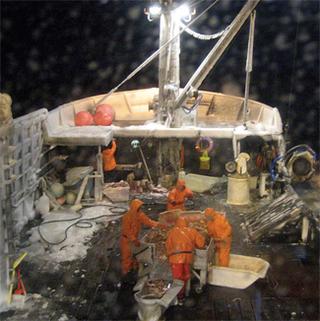Is HDV Dead?
ORLANDO, FLA.
In professional video production, the general trend is toward file-based acquisition. With Canon's recent announcement of a new HD codec for an upcoming camera, does this indicate that the last nail is being pounded into HDV's coffin?

Shows like “The Deadliest Catch” use HDV in production of the series. If you ask many video editors, they might tell you that HDV was "dead on arrival" as far as they are concerned. That sentiment comes from HDV's Long-GOP compression structure and the extra processing power it takes to edit it. On the other hand, ask current users and the manufacturers and the answer will echo Mark Twain's famous cable from London, sent upon learning of his prematurely published obituary: "The reports of my death are greatly exaggerated."
HDV has been around since 2003, with JVC, Sony and Canon as the key professional players. There are two variations: HDV 1, a 19 Mbps 720p format championed by JVC; and HDV 2, a 25Mbps 1080i format used by Canon and Sony. Both compression schemes are built on Long-GOP MPEG-2, but HDV 1 adopted a full-raster frame size (1280x720), while HDV 2 used subsampling (1440x1080).
Since the bandwidth is small enough to move a high-definition signal over a FireWire 400 interface, HDV was one of the initial high-def formats to be natively supported (using the same codec) within nonlinear editors. HDV recordings could be transferred as data from camera or VTR to the editor without any additional decompression and recompression during ingest. HDV was initially taxing on computers, which brought new products to market to help accelerate HDV post production, including Cineform's intermediate codec and real-time I/O hardware from Convergent Designs, Matrox and Avid.
THE ENABLER
Many customers describe HDV as an "enabling" technology. According to Tim Dashwood, a Canadian director of photography closely associated with JVC and HDV, "HDV was the first form of high definition production that was affordable. The tape was cheap, so you could easily build those costs into the expendables portion of your budget. Unfortunately the tape was also the weakness. Because of Long-GOP, a drop-out meant the loss of quite a few frames of content. That's far worse than a drop-out in Beta-SP or HDCAM. Nevertheless, if HDV hadn't been there first, you wouldn't have affordable HD recording to SDHC cards today."
Tim's comments raise some good issues, such as the affordability of media. This has been a concern with P2 cards and to a lesser extent XDCAM discs. There's plenty of tapeless video being recorded, but producers and production insurance companies are wrestling with the issues of storage and long-term archiving of the media. When you analyze the world of HDV, it turns out that quite a few event videographers, reality TV series producers and broadcasters still rely heavily on tape-based HDV. Shows like "Deadliest Catch" owe much of their production style and look to HDV.
Don't expect a lot of new HDV tape products, but manufacturers clearly intend to continue to support HDV for their existing users, while at the same time transitioning to new hybrid products. The exact recording format may have changed, but facilities have built infrastructures around a 25 Mbps pipeline, which means that most future acquisition codecs are going to be variations of MPEG-2 and MPEG-4. Examples of this can be seen in JVC's GY-HM700UXT and Sony's HVRZ7U cameras. The JVC 700 records onto either SxS or SDHC cards and uses the licensed Sony EX codec, which is an evolutionary codec derived out of HDV development. The recording can be "wrapped" as either an MP4 or a Final Cut-ready .MOV file. Sony has taken a hybrid approach with the 7U: It will simultaneously record onto both a Compact Flash card and an HDV videotape. You get the best of both worlds: file-based recording, so you can go straight to editing, coupled with an inexpensive tape that can be held on the shelf for back-up.
NOT THE FUTURE, BUT NOT DEAD EITHER
Canon's new codec will be an MPEG-2 4:2:2 full-raster codec at a data rate of up to 50 Mbps. 4:2:2 sampling offers twice as much color information as HDV's 4:2:0 scheme. The file will be recorded to solid-state media and wrapped in the MXF format. It's unclear whether or not this is the same 50 Mbps codec being used by Sony, but Canon has indicated they are working closely with Apple, Adobe, Avid and Grass Valley to ensure NLE compatibility. A mock-up of a new Canon XL-style video camera was shown recently at InterBEE 2009 in Japan and HD Expo in California. This camera appears to only use solid-state media and presumably will record using Canon's new codec.
In spite of the trend towards file-based production, Canon, Sony and JVC continue to manufacture and sell numerous camcorders and VTRs designed around tape-based HDV acquisition. For instance, JVC still sells a lot of its GY-HD250U camcorder. Sony and Canon each offer seven different HDV camcorder models, while Sony's line-up also includes four different VTR models. HDV may not be the future, but it certainly isn't dead. We can thank HDV for being the enabler that led to products like Sony's NXCAM and EX cameras. If you work with HDV today, you probably aren't ready to move out of the format for a few years yet. Banking on that, I would expect to see tape-based HDV products survive for a number of years to come.
Get the TV Tech Newsletter
The professional video industry's #1 source for news, trends and product and tech information. Sign up below.
